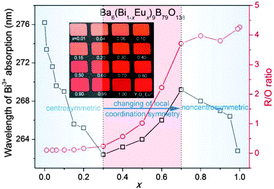Ba6(Bi1−xEux)9B79O138 (0 ≤ x ≤ 1): synergetic changing of the wavelength of Bi3+ absorption and the red-to-orange emission ratio of Eu3+†
Abstract
Very recently, a novel barium bismuth borate Ba6Bi9B79O138 (BBBO) was shown to be a new analogue of REBaB9O16 (RE = rare earth), which is a family of excellent phosphor hosts, because it has two types of cationic positions suitable for bi- and tri-valent activators (or sensitizers). In this study, we prepared Eu3+-to-Bi3+ substituted solid solutions Ba6(Bi1−xEux)9B79O138 (0 ≤ x ≤ 1) and performed a systematic UV-photoluminescence investigation. As anticipated, efficient energy transfer occurs in the whole series of compounds and the majority of the energy absorbed by Bi3+ was transmitted to Eu3+, causing a great enhancement of Eu3+ emission. More interestingly, the Eu3+-to-Bi3+ substitution leads to a centrosymmetric-to-noncentrosymmetric transition of the local coordination symmetry of the trivalent cations due to the size difference between Eu3+ and Bi3+. This is observed in the synergetic changing of the wavelength of Bi3+ 1S0 → 3P1 absorption (excitation spectra) and the red-to-orange emission ratio (emission spectra) when changing x. BBBO is a new polyborate host with a freshly resolved structure whose interesting preliminary results suggest the further development of BBBO-based phosphors.


 Please wait while we load your content...
Please wait while we load your content...